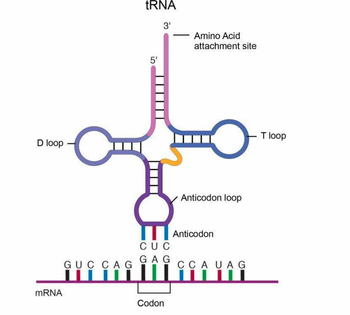
Human Anatomy & Physiology (11th Edition)
11th Edition
ISBN: 9780134580999
Author: Elaine N. Marieb, Katja N. Hoehn
Publisher: PEARSON
expand_more
expand_more
format_list_bulleted
Concept explainers
Topic Video
Question
Is this diagram of tRNA technically incorrect? Shouldn't it be 3' on the left and 5' on the right for the tRNA such that the 5' to 3' codon can match with the antiparallel 3' to 5' anticodon?

Transcribed Image Text:### tRNA Structure
The image illustrates the structure of transfer RNA (tRNA), a key molecule in the translation process of protein synthesis. The tRNA molecule is depicted in a cloverleaf structure which is commonly used to represent its secondary structure. Each functional region is labeled for clarity.
#### Key Components:
1. **Amino Acid Attachment Site (3')**:
- Located at the 3' end of the tRNA molecule.
- This is the site where the amino acid is covalently bonded to the tRNA.
2. **5' End**:
- The opposite end of the polynucleotide chain from the 3' end.
3. **Loops**:
- **D Loop**: Contains dihydrouridine and plays a role in maintaining the structure of tRNA.
- **T Loop**: Contains ribothymidine, pseudouridine, and cytidine, important for tRNA's interaction with ribosomes.
- **Anticodon Loop**: Contains a set of three nucleotides known as the anticodon. This is crucial for base-pairing with the mRNA codon.
4. **Anticodon**:
- Specifically matches the codon on the mRNA during translation.
- In the illustration, the anticodon sequence is CUC, pairing with the mRNA codon GAG.
#### mRNA Interaction:
The bottom part of the image shows the interaction between tRNA and mRNA during translation.
- **mRNA Codon**:
- Comprises groups of three nucleotides called codons.
- Each codon on the mRNA corresponds to a specific amino acid or a stop signal during translation.
- **Codon-Anticodon Pairing**:
- Demonstrates the complementary base pairing between the mRNA codon and the tRNA anticodon.
- For example, the mRNA codon GAG pairs with the tRNA anticodon CUC.
This detailed visualization helps in understanding how tRNA translates the genetic code carried by mRNA into a corresponding sequence of amino acids, ultimately synthesizing proteins.
Expert Solution
This question has been solved!
Explore an expertly crafted, step-by-step solution for a thorough understanding of key concepts.
This is a popular solution
Trending nowThis is a popular solution!
Step by stepSolved in 3 steps with 1 images

Knowledge Booster
Learn more about
Need a deep-dive on the concept behind this application? Look no further. Learn more about this topic, biology and related others by exploring similar questions and additional content below.Similar questions
- In regard to the wobble hypothesis and the fact that cells do not need a full complement of tRNAs for codons. What would the consequences be if a cell lost the tRNA gene with the following anticodon sequences Please explain in depth A. 3'-ACA-5' B. 3'-CUG-5'arrow_forwardWrite all possible codons recognized by each of the given anticodons. An anticodon strand reads 5'-UGA-3'. Fill in the missing base sequences for the possible codons recognized by the anticodon. Codon: 5- Codon: 5'- Codon: 5'- An anticodon strand reads 5'-CGA-3'. Fill in the missing base sequences for the possible codons recognized by the anticodon. Codon: 5'- -3' Codon: 5'- -3' An anticodon strand reads 5'-IAG-3'. Fill in the missing base sequences for the possible codons recognized by the anticodon. Codon: 5'- -3° ينا -3' -3'arrow_forwardWhich of the molecules of RNA is the most likely to fold into a specific structure as a result of intramolecular (within itself) base-pairing? Explain. 5′-CCCUAAAAAAAAAAAAAAAAUUUUUUUUUUUUUUUUAGGG-3′ 5′-UGUGUGUGUGUGUGUGUGUGUGUGUGUGUGUGUGUGUGUG-3′ 5′-AAAAAAAAAAAAAAAAAAAAAAAAAAAAAAAAAAAAAAAA-3′ 5′-GGAAAAGGAGAUGGGCAAGGGGAAAAGGAGAUGGGCAAGG-3′arrow_forward
- Indicate the amino acid sequence of the protein encoded by the following mRNA molecule. Use the genetic code table and assume that the very first “AUG” the ribosome encounters will serve as the start codon and specify methionine. 5’-AAUUCAUGCCCAAAUUUGGGGCACGAAGCUUCUUAGGCUAGUCCUAAAAAA-3’arrow_forwardIn the tertiary structure of tRNA, where is the anticodon region relative to the attachment site for the amino acid? Are these located adjacent to each other?arrow_forwardA tRNA has the anticodon sequence 3ʹ-G A A -5ʹ. Which amino acid is attached to it?arrow_forward
arrow_back_ios
arrow_forward_ios
Recommended textbooks for you
 Human Anatomy & Physiology (11th Edition)BiologyISBN:9780134580999Author:Elaine N. Marieb, Katja N. HoehnPublisher:PEARSON
Human Anatomy & Physiology (11th Edition)BiologyISBN:9780134580999Author:Elaine N. Marieb, Katja N. HoehnPublisher:PEARSON Biology 2eBiologyISBN:9781947172517Author:Matthew Douglas, Jung Choi, Mary Ann ClarkPublisher:OpenStax
Biology 2eBiologyISBN:9781947172517Author:Matthew Douglas, Jung Choi, Mary Ann ClarkPublisher:OpenStax Anatomy & PhysiologyBiologyISBN:9781259398629Author:McKinley, Michael P., O'loughlin, Valerie Dean, Bidle, Theresa StouterPublisher:Mcgraw Hill Education,
Anatomy & PhysiologyBiologyISBN:9781259398629Author:McKinley, Michael P., O'loughlin, Valerie Dean, Bidle, Theresa StouterPublisher:Mcgraw Hill Education, Molecular Biology of the Cell (Sixth Edition)BiologyISBN:9780815344322Author:Bruce Alberts, Alexander D. Johnson, Julian Lewis, David Morgan, Martin Raff, Keith Roberts, Peter WalterPublisher:W. W. Norton & Company
Molecular Biology of the Cell (Sixth Edition)BiologyISBN:9780815344322Author:Bruce Alberts, Alexander D. Johnson, Julian Lewis, David Morgan, Martin Raff, Keith Roberts, Peter WalterPublisher:W. W. Norton & Company Laboratory Manual For Human Anatomy & PhysiologyBiologyISBN:9781260159363Author:Martin, Terry R., Prentice-craver, CynthiaPublisher:McGraw-Hill Publishing Co.
Laboratory Manual For Human Anatomy & PhysiologyBiologyISBN:9781260159363Author:Martin, Terry R., Prentice-craver, CynthiaPublisher:McGraw-Hill Publishing Co. Inquiry Into Life (16th Edition)BiologyISBN:9781260231700Author:Sylvia S. Mader, Michael WindelspechtPublisher:McGraw Hill Education
Inquiry Into Life (16th Edition)BiologyISBN:9781260231700Author:Sylvia S. Mader, Michael WindelspechtPublisher:McGraw Hill Education

Human Anatomy & Physiology (11th Edition)
Biology
ISBN:9780134580999
Author:Elaine N. Marieb, Katja N. Hoehn
Publisher:PEARSON

Biology 2e
Biology
ISBN:9781947172517
Author:Matthew Douglas, Jung Choi, Mary Ann Clark
Publisher:OpenStax

Anatomy & Physiology
Biology
ISBN:9781259398629
Author:McKinley, Michael P., O'loughlin, Valerie Dean, Bidle, Theresa Stouter
Publisher:Mcgraw Hill Education,

Molecular Biology of the Cell (Sixth Edition)
Biology
ISBN:9780815344322
Author:Bruce Alberts, Alexander D. Johnson, Julian Lewis, David Morgan, Martin Raff, Keith Roberts, Peter Walter
Publisher:W. W. Norton & Company

Laboratory Manual For Human Anatomy & Physiology
Biology
ISBN:9781260159363
Author:Martin, Terry R., Prentice-craver, Cynthia
Publisher:McGraw-Hill Publishing Co.

Inquiry Into Life (16th Edition)
Biology
ISBN:9781260231700
Author:Sylvia S. Mader, Michael Windelspecht
Publisher:McGraw Hill Education